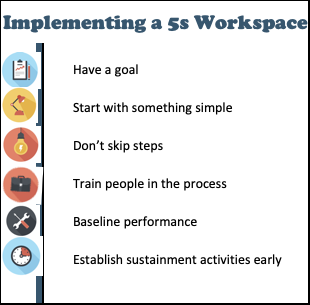
As its name implies, a 5s workspace is constructed utilizing the 5s methodology. A 5s workspace is built on the premise that an organized, standardised and cleaner workplace is more effective, delivering improved levels of output with less waste.
5S is a methodology that can provide the tools to help you organize your workspace. It follows five simple steps:
- Sort
- Set in order
- Shine
- Standardize
- Sustain
In today’s article, we’ll be exploring what is a 5s workspace, the process of attaining one together with its key benefits and issues.
We’ll be covering:
What is the 5s workspace?
Our working environment can be a busy place. As a result, it’s unsurprising that it can also become a cluttered one.
Clutter coupled with disorganization can, over time, leave a workspace not only untidy but also ineffective.
The challenges of a disorganized and untidy workspace of varied; they can include
- An inability to find tools and equipment
- Waste
- A higher likelihood of non-conforming processes
- Lost pride in performance due to surroundings
Whilst there are various tools and methods that can be used to produce an organized workspace, perhaps the most common is 5S.
5S originated in Toyota Japanese lean and features five different tools to help develop an effective workspace.
- Sort – Maintain a tidy environment, remove unnecessary tools and equipment
- Set in order – Organize your workspace so that equipment is stored correctly
- Shine – Clean the workspace
- Standardize – Incorporate 5s processes into standard procedures
- Sustain – Maintain a regular cycle of 5s assessment
So what does the 5s workspace mean in reality? You can use the 5s methodology to organize your workspace by
- Identifying and Removing items that shouldn’t be there
- Organizing tools and equipment, so you know where things are:
- Cleaning your work area
- Helping to develop habits that sustain an effective workspace.
A 5S workspace is often used as a name to describe an area where 5S has been deployed and is beginning to see the benefits.
How to implement the 5s workspace
When it comes to implementing 5s in your workspace, I’d consider five key things that, in my opinion, drive a successful implementation:

- Have a goal
- Start with something that you can have relatively easy success with
- Follow the process and don’t skip steps.
- If you’re engaging with a team, ensure they are knowledgeable about two things:
- The process – don’t just assume that because 5s is relatively simple, people will “just understand.”
- The workspace they are engaged with
- Be sure to baseline performance to act on specific areas and measure the results following your 5s session.
- Ensure that you train staff and consider training workshops supported by appropriate training material to increase awareness and knowledge of the process.
- Be sure that those implementing 5s know what good looks like and how to measure success.
- Be sure to establish routine sustainment programs.
Key Benefits of the 5s workspace
The benefits of 5s workspaces are widely published, and you should expect to see improvements through:
- Organized workspace
- Increased efficiency
- Increased safety
- A uniform way of working
- An opportunity to engage staff.
Issues with the 5s workspace
Despite being commonly used, there are still some issues to watch out for. These include:
- Lack of training – Don’t just assume that because the 5s methodology is simple, people will understand how to do it from day 1. Familiarisation training can help substantially.
- Unrealistic goals – Expected benefits should be relatively clear from the outset. Make sure that your goals are realistic; for example – 5s is unlikely to solve all your organization’s issues.
- Lack of sustainment – perhaps the key issue in many organizations is that 5s is used as a one-off event that is then not sustained. Benefits are short-lived, and issues quickly find themselves recurring.
- Lack of performance baseline – if you’re looking to be able to demonstrate the performance gains achieved through 5s then you must have a baseline in order to contrast with. A failure to do this means that you will be unable to credibly assess your 5s implementation.
- Minor improvements due to poor implementation of the methodology
- Lack of senior support within your organization may result in higher priorities or a failure to grasp the potential benefits of the method.
Summary
5s is a commonly used continuous improvement tool. It’s a straightforward methodology to implement and has proven results.
The 5s workspace is a workspace or area that has undergone a 5s program to drive improvement through making changes such as cleaning, removing unnecessary tools etc.
While relatively simple to implement, there are numerous issues to watch out for, including setting unrealistic goals or failing to sustain the program.
Have you applied 5s in your workspace? How did you find the results? Have you any lessons learned that you’d like to share with our readers?
As ever, you can reach us on Twitter or via the comments section below.
